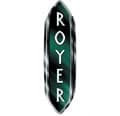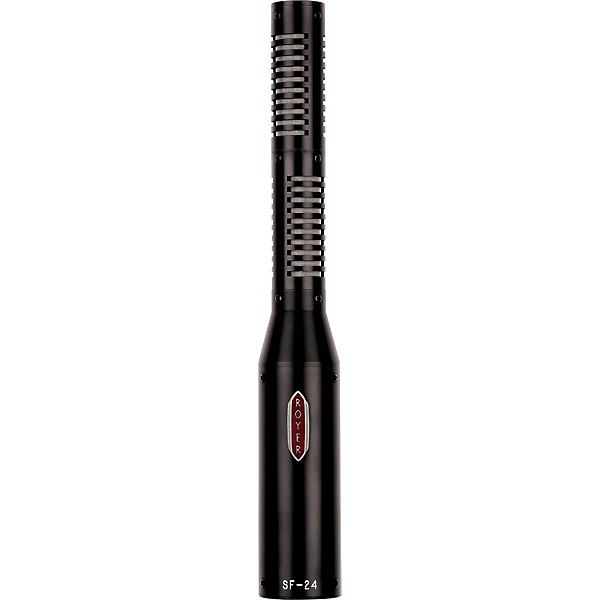Gear SpecialistBundlingMusician
Royer SF-24 LIVE Active Ribbon Mic Black Chrome
(0)|Q&A|Item #:1274319728017
Special order: Place an order for this item today and we’ll get it to you soon.
Notify me when this item is in stock.
6-month special financing^ + $429 back in Rewards** Limited time Learn More
Protect your gearLearn more
Cover drops, spills or cracks with Pro Coverage
Save on orders $199+ and get expert advice from a Gear Adviser
Need Help?

Description
Royer microphones are built to be tough and can handle the challenges of life on the road, but they are studio mics that require some TLC to keep from damaging the ribbon elements. With the Royer SF-24 ribbon microphone from the Live Series, you get twice the durability in the ribbon element, allowing you to place it anywhere on stage you'd like with complete confidence. Tame high-end harshness and bring Royer's legendary smoothness, warmth and power to your live performances.
How
After extensive testing, Royer found new ribbon thickness for the SF-24 Live microphone that allowed them to significantly increase durability with minimal reduction in gain and transients response. The sonic difference is negligible, and the increased durability lets anyone use Royer ribbons in a live environment.
A Figure-8 Microphone on Stage?
Surprisingly, figure-8 ribbon microphones are an excellent solution for bleed. Bleed can be a real problem with many onstage mics-not just the amount of bleed but the quality of the bleed. Here's how Royer handles the problem.
Rejection
Royer ribbon mics are figure-8, picking up sound from the front and rear of the microphone, and rejecting sounds approaching from a) the left and right sides of the mic, b) the top of the mic, and c) the bottom of the mic. These are extremely effective dead zones that engineers use to isolate instruments by positioning the mics in such a way that the dead zones face, and cancel, offending sound sources.
Off-Axis Coloration:
There's a lot of sound on a live stage and you can't entirely control for off-axis information getting into microphones, even ribbons. Most microphones color off-axis information in highly unflattering ways, which is why bleed can sound so nasty. Ribbons don't color off-axis information, so any bleed that manages to get into your onstage Royer SF-24 mic will sound natural, not harsh or colored
About Royer Live Series mics:
Royer Live Series mics (R-121L, R-122L, SF-24L) were introduced in 2008, making ribbon mics available to FOH engineers for the first time. As a group they won the 2008 TEC Award for Microphone Technology/Sound Reinforcement, and they're showing up in performance venues around the world.
Royer Live Series mics use thicker ribbon elements - carefully chosen for increased durability and minimal sonic variation from their studio brethren. The thicker ribbons have a slightly slower transient response, resulting in softer highs.
Live Series mics are identified by their red logos (studio models have green logos). Live models can be converted to a Studio model any time - Royer simply re-ribbons the mic to studio spec and replaces the red logo with a green logo.
Like any high-end microphone, Royer Live Series mics need to be handled carefully during setup and tear-down. Proper handling and storage in a dedicated microphone container will assure years of reliable service.
Royer Live Series on the road with
:
Keith Urban
- SF-24L drum overhead
- R-122L's on Keith's guitar cabinets
Phish
- SF-24L on drum overheads
- R-122L's on guitar cabinets
The Rolling Stones
- SF-24 on drum overhead for recording
Green Day
- R-121's on guitar cabinets
Arturo Sandoval
- R-122L for solo trumpet (all other stage mics by Shure)
Jeff Beck
- R-121's on guitar cabinets
Matchbox Twenty
- R-121L's on guitar cabinets
Maroon Five
- R-121L's on guitar cabinets
Aerosmith
- R-121L's on guitar cabinets
Wayne Shorter
- R-122L's on drum overheads and in front of kick
- R-122L on sax
George Thorogood
- R-121 on electric guitar
Barry Manilow
- R-122's on brass
Fleetwood Mac
- R-121's on guitar cabinets
Al Dimiola
- R-121L's on guitar cabinets
Brian Setzer
- R-121L on guitar cabinet
- SF-24L on drum overhead
Train
- R-121L's on guitar cabinets
Harry Connick Jr.
- 122's on brass section
Arturo Sandoval
- R-122 on solo trumpet
The Goo Goo Dolls
- R-121L's on electric guitars
Thursday
- R-121's on electric guitars
How
After extensive testing, Royer found new ribbon thickness for the SF-24 Live microphone that allowed them to significantly increase durability with minimal reduction in gain and transients response. The sonic difference is negligible, and the increased durability lets anyone use Royer ribbons in a live environment.
A Figure-8 Microphone on Stage?
Surprisingly, figure-8 ribbon microphones are an excellent solution for bleed. Bleed can be a real problem with many onstage mics-not just the amount of bleed but the quality of the bleed. Here's how Royer handles the problem.
Rejection
Royer ribbon mics are figure-8, picking up sound from the front and rear of the microphone, and rejecting sounds approaching from a) the left and right sides of the mic, b) the top of the mic, and c) the bottom of the mic. These are extremely effective dead zones that engineers use to isolate instruments by positioning the mics in such a way that the dead zones face, and cancel, offending sound sources.
Off-Axis Coloration:
There's a lot of sound on a live stage and you can't entirely control for off-axis information getting into microphones, even ribbons. Most microphones color off-axis information in highly unflattering ways, which is why bleed can sound so nasty. Ribbons don't color off-axis information, so any bleed that manages to get into your onstage Royer SF-24 mic will sound natural, not harsh or colored
About Royer Live Series mics:
Royer Live Series mics (R-121L, R-122L, SF-24L) were introduced in 2008, making ribbon mics available to FOH engineers for the first time. As a group they won the 2008 TEC Award for Microphone Technology/Sound Reinforcement, and they're showing up in performance venues around the world.
Royer Live Series mics use thicker ribbon elements - carefully chosen for increased durability and minimal sonic variation from their studio brethren. The thicker ribbons have a slightly slower transient response, resulting in softer highs.
Live Series mics are identified by their red logos (studio models have green logos). Live models can be converted to a Studio model any time - Royer simply re-ribbons the mic to studio spec and replaces the red logo with a green logo.
Like any high-end microphone, Royer Live Series mics need to be handled carefully during setup and tear-down. Proper handling and storage in a dedicated microphone container will assure years of reliable service.
Royer Live Series on the road with
:
Keith Urban
- SF-24L drum overhead
- R-122L's on Keith's guitar cabinets
Phish
- SF-24L on drum overheads
- R-122L's on guitar cabinets
The Rolling Stones
- SF-24 on drum overhead for recording
Green Day
- R-121's on guitar cabinets
Arturo Sandoval
- R-122L for solo trumpet (all other stage mics by Shure)
Jeff Beck
- R-121's on guitar cabinets
Matchbox Twenty
- R-121L's on guitar cabinets
Maroon Five
- R-121L's on guitar cabinets
Aerosmith
- R-121L's on guitar cabinets
Wayne Shorter
- R-122L's on drum overheads and in front of kick
- R-122L on sax
George Thorogood
- R-121 on electric guitar
Barry Manilow
- R-122's on brass
Fleetwood Mac
- R-121's on guitar cabinets
Al Dimiola
- R-121L's on guitar cabinets
Brian Setzer
- R-121L on guitar cabinet
- SF-24L on drum overhead
Train
- R-121L's on guitar cabinets
Harry Connick Jr.
- 122's on brass section
Arturo Sandoval
- R-122 on solo trumpet
The Goo Goo Dolls
- R-121L's on electric guitars
Thursday
- R-121's on electric guitars
Features
- Phantom powered circuitry provides high output and impedance matching
- High SPL Capabilities
- No distortion up to maximum SPL rating
- Extremely low residual noise
- Ribbon element is not affected by heat or humidity
- Absence of high frequency phase distortion
- Equal sensitivity from front or back of element
- Consistent frequency response regardless of distance
- Rear side of mic records slightly brighter when three feet or closer to sound source
- Protective wood case
- Microphone sock
- One year ribbon element warranty




